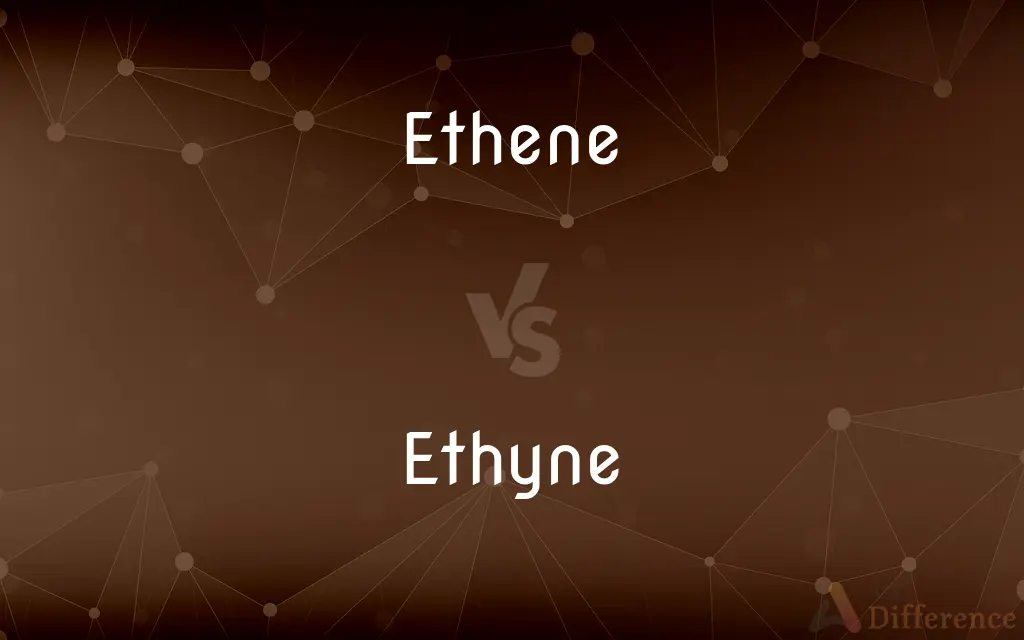Ethene vs. Ethyne — What's the Difference?
By Tayyaba Rehman — Published on November 4, 2023
Ethene is a hydrocarbon with a double bond (C2H4), while Ethyne has a triple bond (C2H2). Both are simple alkenes and alkynes, respectively.

Difference Between Ethene and Ethyne
Table of Contents
ADVERTISEMENT
Comparison Chart
Bond Type
Double bond
Triple bond
Molecular Formula
C2H4
C2H2
Common Name
Ethylene
Acetylene
Reactivity
Reactive
Highly reactive
Main Industrial Use
Production of polyethylene
Welding (as fuel for oxyacetylene flame)
ADVERTISEMENT
Compare with Definitions
Ethene
Ethene belongs to the alkene family due to its carbon-carbon double bond.
The double bond makes Ethene reactive in addition reactions.
Ethyne
Ethyne is classified as an alkyne due to its carbon-carbon triple bond.
The triple bond gives Ethyne its characteristic reactivity.
Ethene
Ethene has a molecular formula of C2H4.
Ethene's double bond is key to its many industrial applications.
Ethyne
Ethyne is a hydrocarbon with a triple bond.
Ethyne produces a high-temperature flame when burned.
Ethene
Ethene is a gaseous hydrocarbon with a double bond.
Ethene is crucial in the production of many plastics.
Ethyne
Ethyne's molecular formula is C2H2.
Despite its simplicity, Ethyne has a range of applications.
Ethene
Ethene is an unsaturated hydrocarbon.
Unsaturated hydrocarbons like Ethene can undergo addition reactions.
Ethyne
Ethyne is commonly referred to as acetylene.
Welders often use Ethyne, or acetylene, in combination with oxygen.
Ethene
Ethene is also termed as ethylene in various contexts.
Ethene, or ethylene, acts as a plant hormone.
Ethyne
Ethyne is an unsaturated molecule with high reactivity.
The reactivity of Ethyne is evident in its usage in welding.
Ethene
See ethylene.
Ethyne
See acetylene.
Ethene
The organic chemical compound ethylene. The simplest alkene, a colorless gaseous (at room temperature and pressure) hydrocarbon with the chemical formula C2H4
Ethyne
The organic compound acetylene. The simplest alkyne, a colorless gaseous (at room temperature and pressure) hydrocarbon with the chemical formula C2H2.
Ethene
(organic chemistry) Any alkene derived from ethylene
Ethyne
A colorless flammable gas used chiefly in welding and in organic synthesis
Ethene
Ethylene; olefiant gas.
Ethene
A flammable colorless gaseous alkene; obtained from petroleum and natural gas and used in manufacturing many other chemicals; sometimes used as an anesthetic
Common Curiosities
What kind of bond does Ethene have?
A double bond.
For what industrial purpose is Ethyne widely used?
Welding, specifically in oxyacetylene flames.
Is Ethene also called something else?
Yes, it's also known as ethylene.
Why is Ethene significant in plant biology?
It acts as a hormone regulating growth and ripening.
Which of the two, Ethene or Ethyne, is more reactive?
Ethyne, due to its triple bond.
What is the molecular formula of Ethene?
C2H4.
Which hydrocarbon, Ethene or Ethyne, is used in the production of plastics?
Ethene.
Which of the two, Ethene or Ethyne, is associated with welding applications?
Ethyne.
Is Ethene an alkane, alkene, or alkyne?
It's an alkene.
How does Ethyne differ from Ethene in terms of bonding?
Ethyne has a triple bond, while Ethene has a double bond.
How about Ethyne?
It's an alkyne.
And Ethyne?
C2H2.
Why is Ethyne also called acetylene?
It's just a common name for the same molecule.
Do both Ethene and Ethyne occur naturally?
Yes, but Ethene has more natural sources, especially in plants.
Which gas has a garlic-like smell, Ethene or Ethyne?
Ethyne.
Share Your Discovery

Previous Comparison
Glucose C vs. Glucose D
Next Comparison
Persian Gulf vs. Arabian SeaAuthor Spotlight
Written by
Tayyaba RehmanTayyaba Rehman is a distinguished writer, currently serving as a primary contributor to askdifference.com. As a researcher in semantics and etymology, Tayyaba's passion for the complexity of languages and their distinctions has found a perfect home on the platform. Tayyaba delves into the intricacies of language, distinguishing between commonly confused words and phrases, thereby providing clarity for readers worldwide.













































